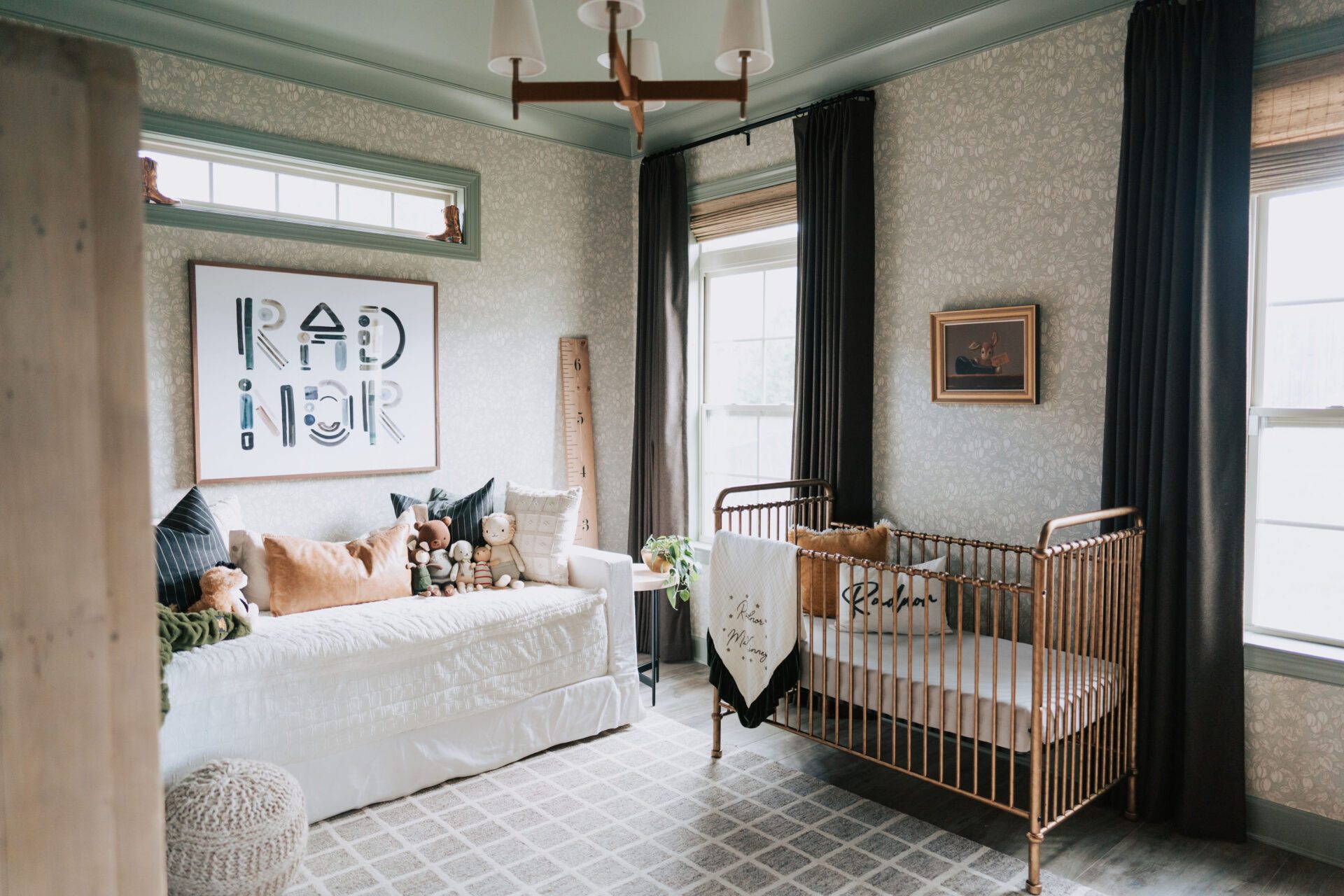A nursery is more than just a room; it’s the first environment your little one will experience, a sanctuary where memories begin. The resurgence of vintage aesthetics in baby boy nurseries brings warmth, character, and timeless charm that modern designs often lack.
These nostalgic spaces blend whimsical elements with practical functionality, creating an ambiance that grows alongside your child.
Vintage-inspired nurseries evoke a sense of heritage and craftsmanship that’s increasingly coveted in our mass-produced world. By incorporating heirloom pieces, weathered textures, and traditional motifs, you can create a space that feels both comforting and sophisticated.
The juxtaposition of old-world charm with contemporary necessities yields a nursery that’s both pragmatic and enchanting—a veritable tableau of childhood wonder infused with historical resonance.
Vintage Baby Boy Nursery Ideas
As we explore these fifteen vintage nursery ideas, you’ll discover how to transform ordinary spaces into extraordinary havens that honor the past while welcoming your family’s newest addition.
Whether you’re drawn to rustic farmhouse elements, mid-century modern influences, or Victorian-era elegance, these timeless approaches offer inspiration for creating a unique space that reflects your style and nurtures your baby boy’s development.
1. Restored Wooden Cribs
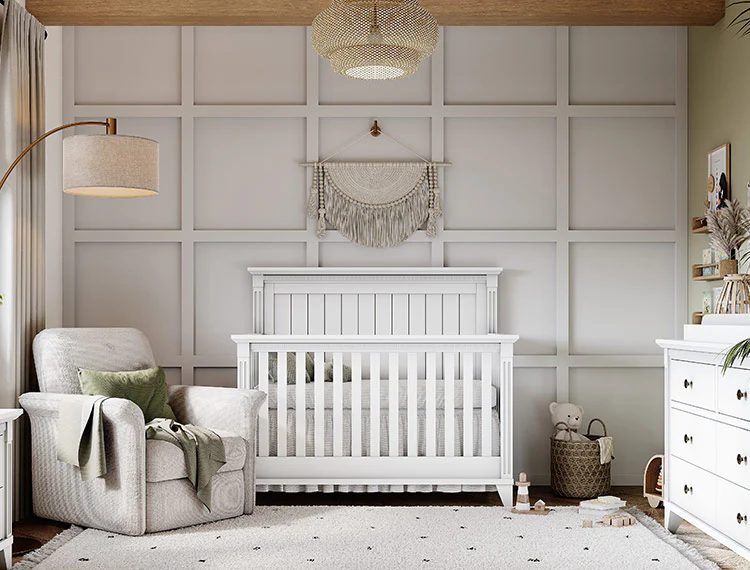
Nothing embodies vintage charm quite like a beautifully restored wooden crib. These timeless pieces serve as the centerpiece of any nursery, offering both historical significance and practical durability. Look for convertible models from the mid-20th century that can transform from cribs to toddler beds, extending their usefulness as your child grows.
When sourcing vintage cribs, prioritize safety by ensuring the restoration includes updating to current safety standards. This may involve replacing hardware, reinforcing joints, or adjusting slat spacing.
The rich patina of aged wood brings warmth to the room while the craftsmanship—often featuring hand-carved details, spindle designs, or curved headboards—adds architectural interest that mass-produced furniture simply cannot replicate.
2. Antique Dresser Changing Tables
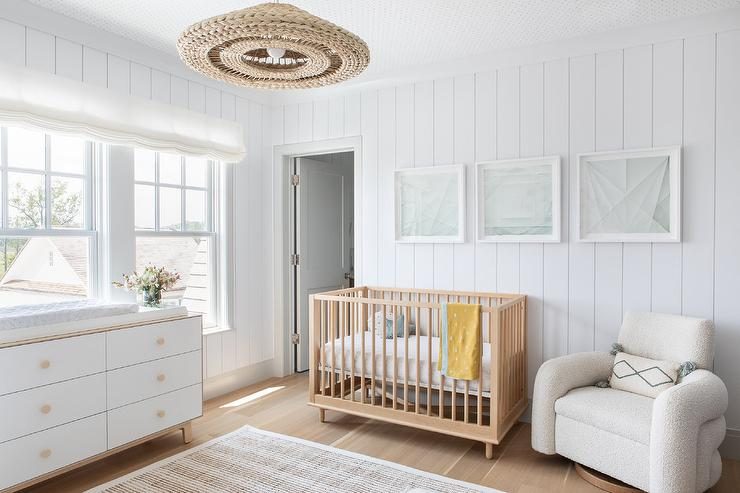
Repurposing antique dressers as changing tables represents the perfect marriage of form and function in vintage nursery design. These substantial pieces offer abundant storage for diapers, clothing, and supplies while their sturdy construction provides a secure changing surface when topped with a padded changing mat.
Victorian or Art Deco dressers with ornate hardware and bowed fronts bring distinctive character to the nursery. The weathered imperfections tell a story, creating a lived-in atmosphere that feels immediately comfortable.
Consider dressers with varying drawer sizes to accommodate different storage needs, and if the piece is particularly valuable, protect its surface with a clear polyurethane coating that preserves the original finish while making it practical for daily use.
3. Classic Rocking Chairs
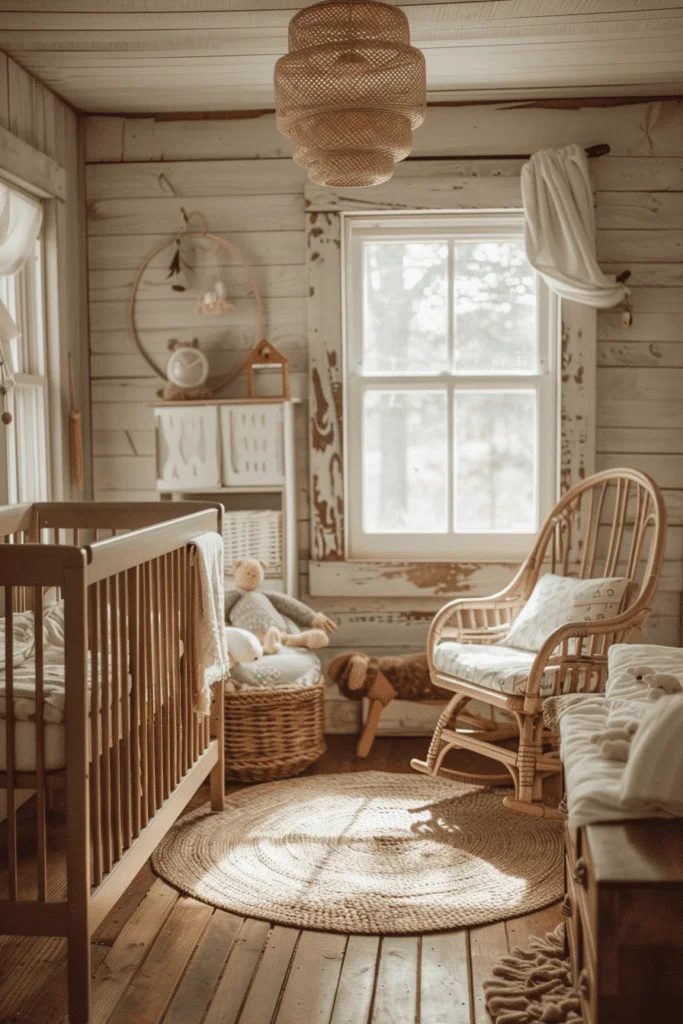
A traditional wooden rocking chair creates both a functional nursing station and a nostalgic focal point in a vintage-inspired nursery. These iconic pieces have soothed generations of babies with their gentle, rhythmic motion. Look for Bentwood rockers, Windsor styles, or hand-carved designs that showcase craftsmanship from bygone eras.
Enhance comfort by adding custom cushions in fabrics that complement your nursery’s color scheme. Period-appropriate choices might include ticking stripes, small florals, or muted plaids. Position the rocker near a window where natural light creates the perfect reading nook for bedtime stories and early morning feedings. The chair will likely become the spot where some of your most precious bonding moments occur.
Related Guide: 10 Vintage Hunting Nursery Ideas for Your Little Explorer
4. Vintage Transportation Theme
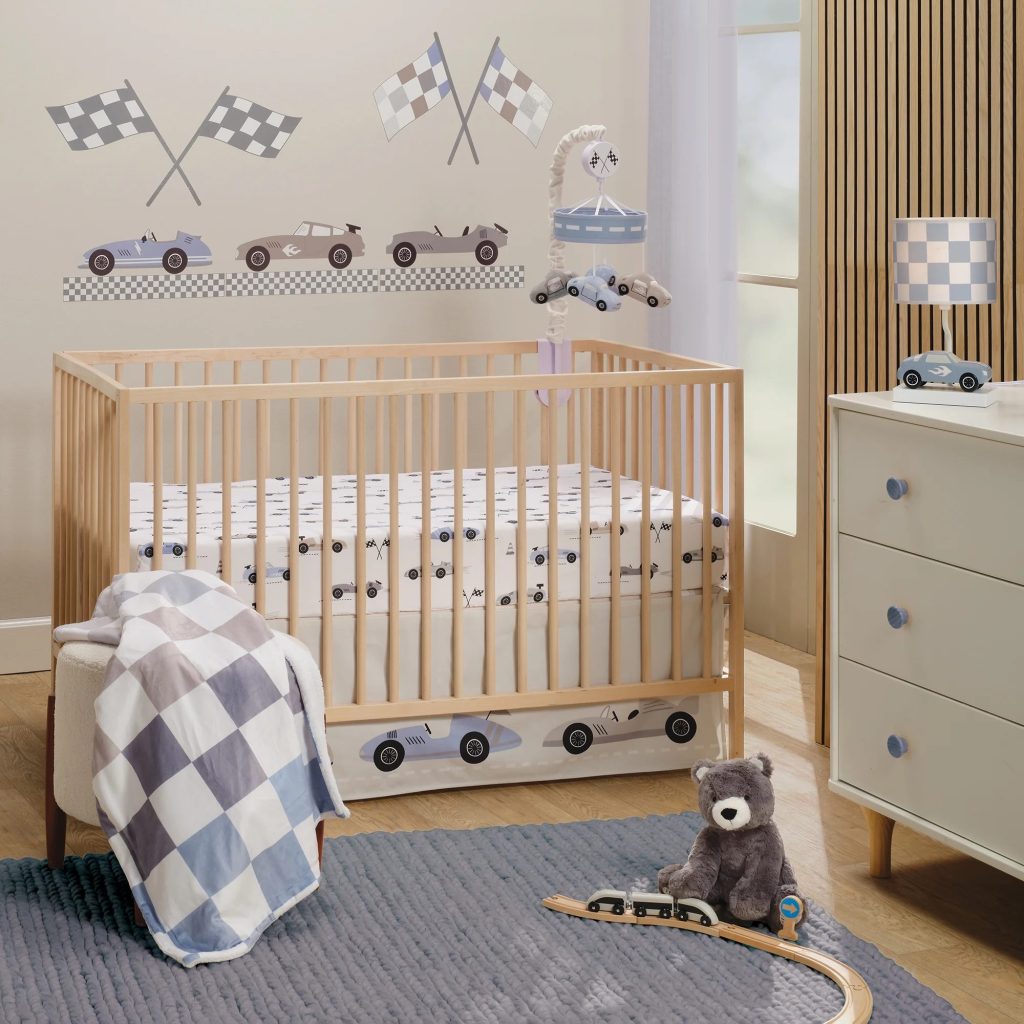
Capture boyhood wonder with transportation motifs from earlier eras—classic cars, steam locomotives, vintage airplanes, and sailing ships. These elements evoke a sense of adventure and exploration perfect for stimulating a young boy’s imagination. Rather than cartoonish renderings, look for realistic illustrations or models that maintain sophistication.
Incorporate the theme through framed technical drawings, antique toy displays mounted safely above the crib, or wallpaper featuring vintage transportation patents. This approach works particularly well when balanced with neutral furnishings that prevent the room from becoming overstimulating. Vintage metal pedal cars or hand-carved wooden trains displayed on high shelves serve as both decoration and future playthings as your child grows.
5. Nautical Heritage Design
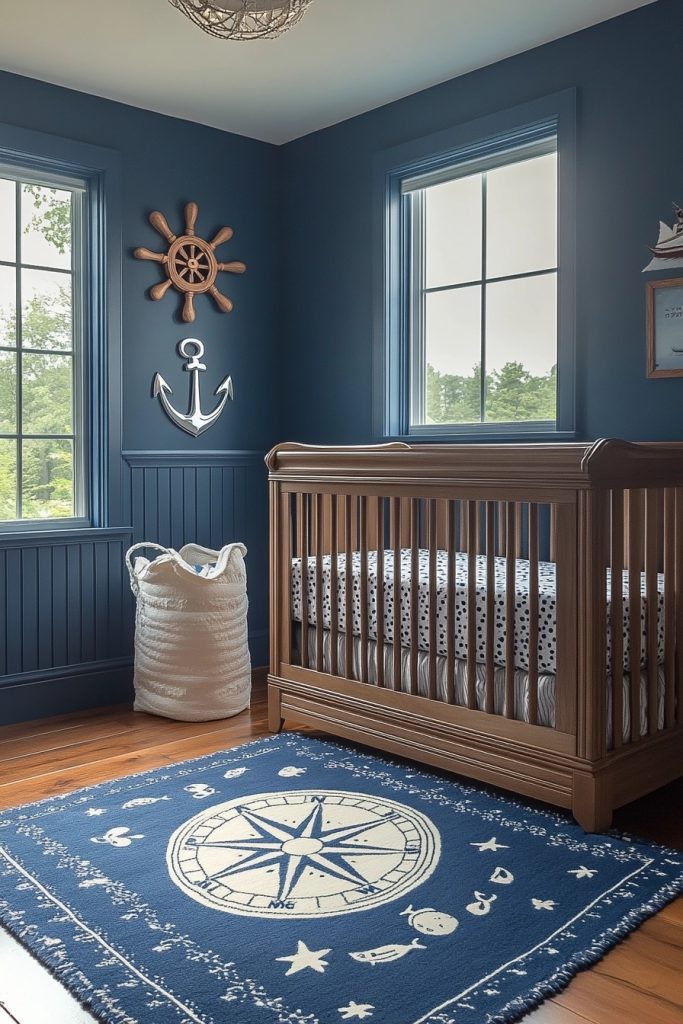
Maritime themes have adorned boys’ rooms for centuries, making them a natural fit for vintage nurseries. Traditional nautical elements—compass roses, antique maps, ship wheels, and captain’s instruments—create a worldly atmosphere that encourages dreams of distant shores. This timeless theme balances masculinity with whimsy.
For authentic vintage appeal, incorporate actual nautical antiques like salvaged portholes (secured safely to walls), navigation instruments displayed under glass, or framed sea charts. Paint walls in classic navy blue or seafoam green, then accent with weathered white trim to evoke coastal cottages. Complete the look with rope details, canvas storage bins, and bedding featuring subtle compass or anchor motifs.
6. Library-Inspired Book Nooks
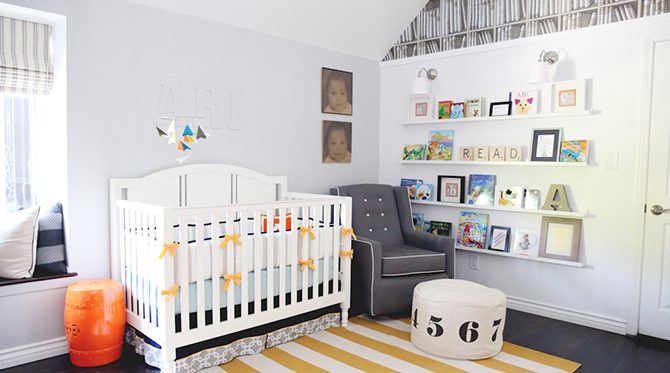
Creating a vintage library corner celebrates literature while establishing early reading habits. Install reclaimed wooden shelving or repurpose an antique bookcase to display classic children’s books with their beautiful illustrated covers facing outward. Titles from the early to mid-20th century often feature remarkable cover art that doubles as nursery decoration.
Enhance the scholarly atmosphere with a small antique desk or table that can later serve for coloring and early learning activities. Vintage globes, microscopes, or telescopes (placed safely out of reach) add intellectual curiosity to the space. Complete this reading retreat with comfortable floor cushions, a small armchair scaled for toddlers, and warm, adjustable lighting that facilitates bedtime stories without disrupting sleep routines.
7. Traditional Farmhouse Elements
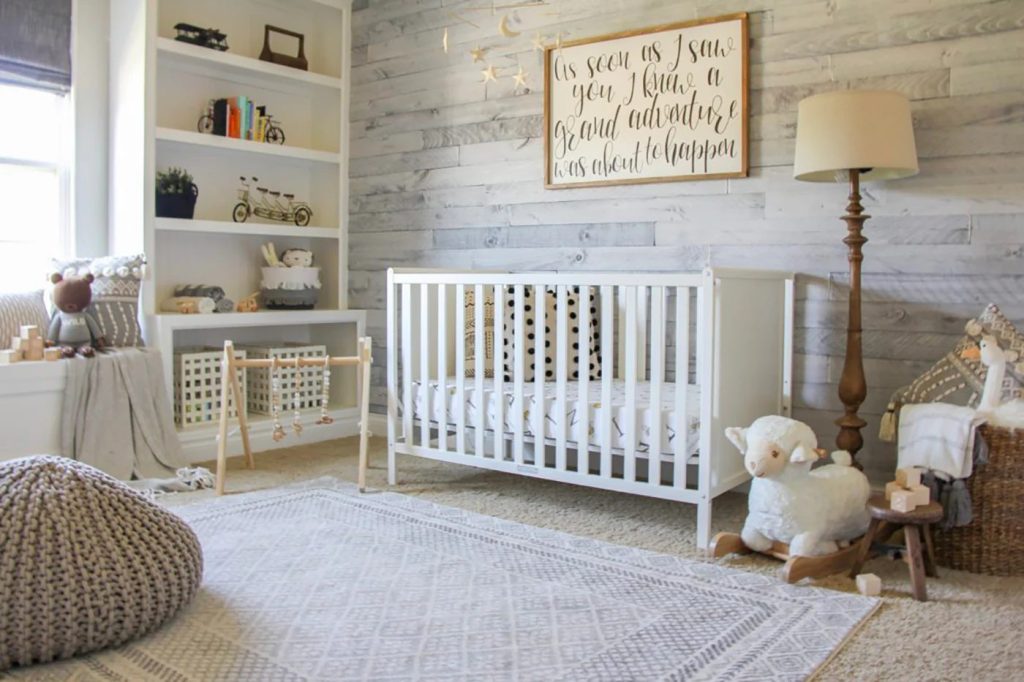
Rural farmhouse aesthetics bring warmth and simplicity to a vintage nursery through elements like shiplap walls, exposed beams, and repurposed agricultural implements. This approach celebrates honest materials and straightforward craftsmanship, creating a nurturing environment free from contemporary distractions.
Incorporate galvanized metal storage bins, antique wooden crates repurposed as toy boxes, and quilts made from heritage patterns. Wall displays might feature vintage seed packets, antique garden tools mounted safely as art, or framed illustrations from classic agricultural almanacs. The color palette typically employs cream, barn red, and weathered blues that create a soothing backdrop for sleep while still stimulating visual development during wakeful periods.
8. Aviation-Themed Ceiling Treatments
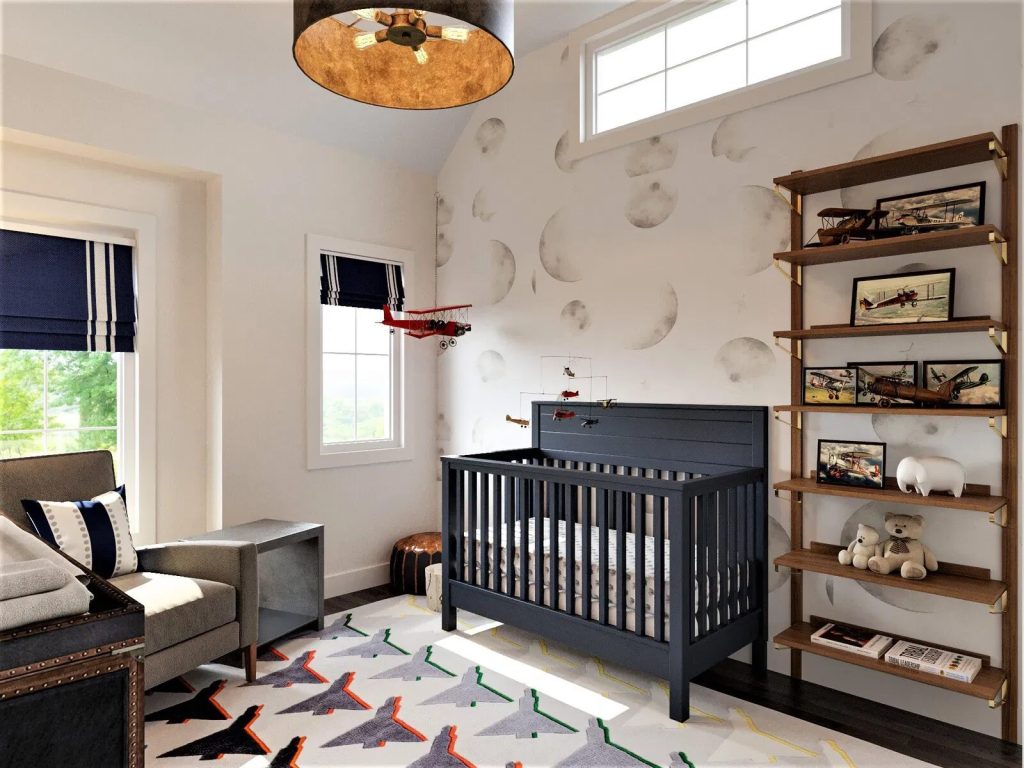
Transform the often-neglected ceiling into a focal point with vintage aviation elements. Suspend carefully restored wooden airplane models or fabric reproductions of early aircraft to create movement and visual interest above the crib. This approach stimulates visual tracking skills crucial for early development while adding dimensional interest to the room.
Complement overhead elements with cloud-painted ceilings or astronomical charts that reference early navigation techniques. Period-appropriate ceiling medallions can anchor light fixtures resembling propellers or celestial bodies. This overhead treatment works especially well in rooms with traditional architecture, where crown molding and higher ceilings provide proper scale for suspended elements.
9. Heritage Sports Accents
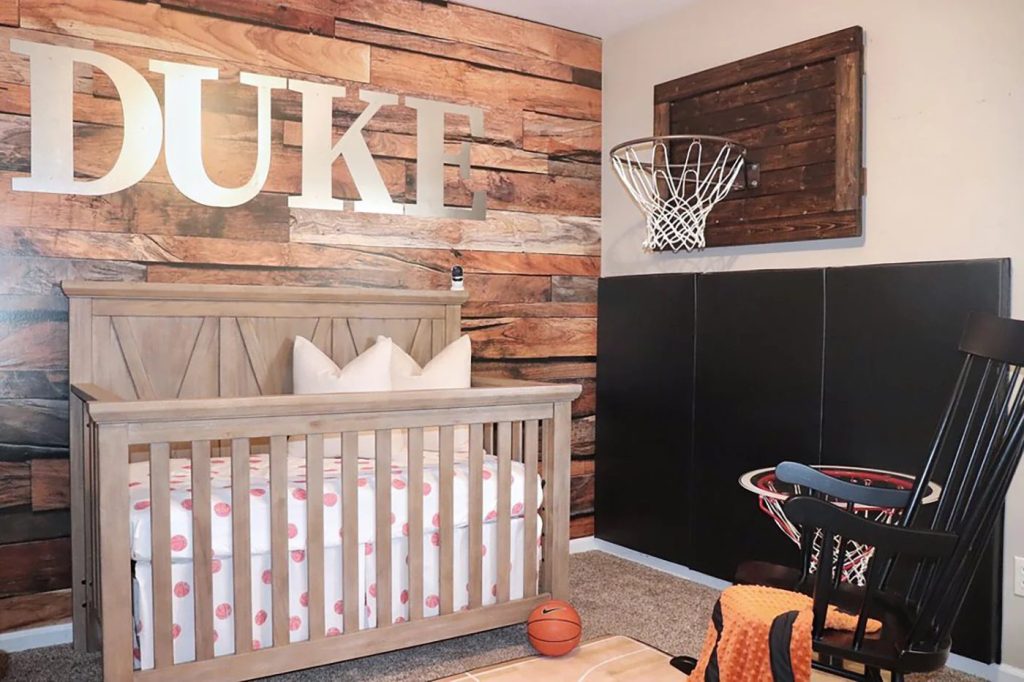
Vintage sports equipment brings nostalgic masculine energy to a baby boy’s nursery through iconic items like leather football helmets, aged baseball gloves, or wooden tennis racquets. Unlike contemporary sports themes that often feel commercial, these heritage items possess authentic character and craftsmanship that elevate the nursery’s design.
Display these sporting goods as wall art or within glass-fronted cabinets that protect both the items and your child. Complement larger pieces with period photographs of historic sporting events, vintage team pennants, or framed sports card collections. The worn leather, aged wood, and muted colors of authentic equipment add texture and interest without introducing garish team colors that might quickly feel dated.
Related Guide: 15 Innovative Jungle Theme Nursery Ideas
10. Antique Map Installations
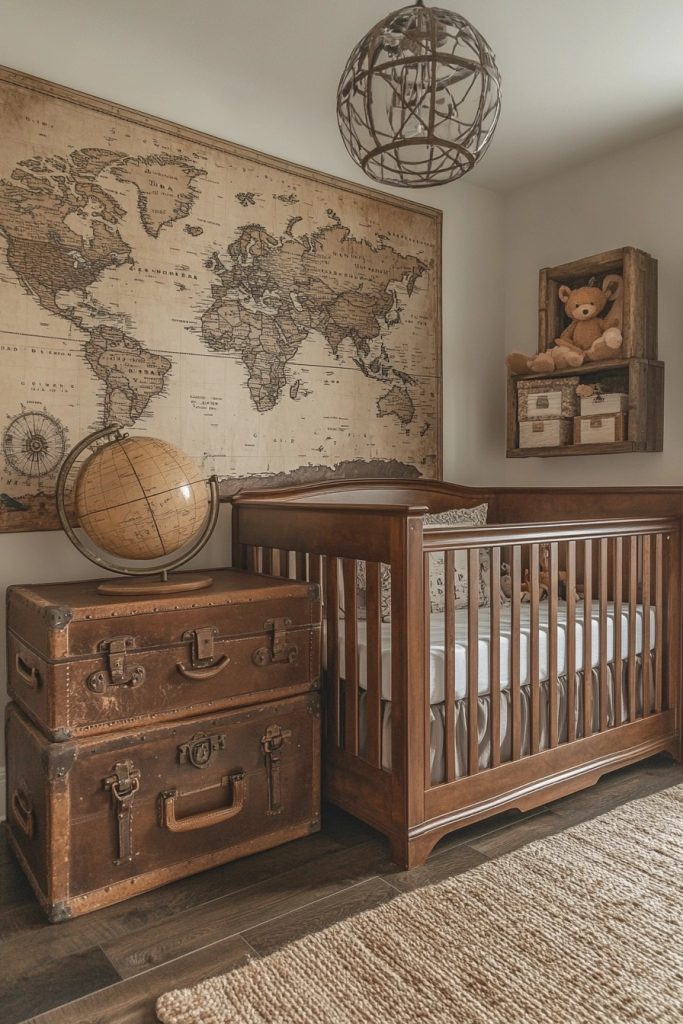
World maps from previous centuries bring educational value and sophisticated visual impact to vintage nurseries. Large-scale reproductions of cartographic treasures—featuring sea monsters, elaborate compass roses, and hand-drawn territories—spark imagination while subtly introducing geography and history.
Create dramatic impact by covering an entire wall with a map mural, or frame smaller sections of antique atlases for a gallery arrangement. Maps with sepia tones, muted blues, and antiqued parchment colors complement most vintage design schemes. These installations grow with your child, transitioning seamlessly from nursery decoration to educational tool for an older boy’s room.
11. Old-World Animal Motifs
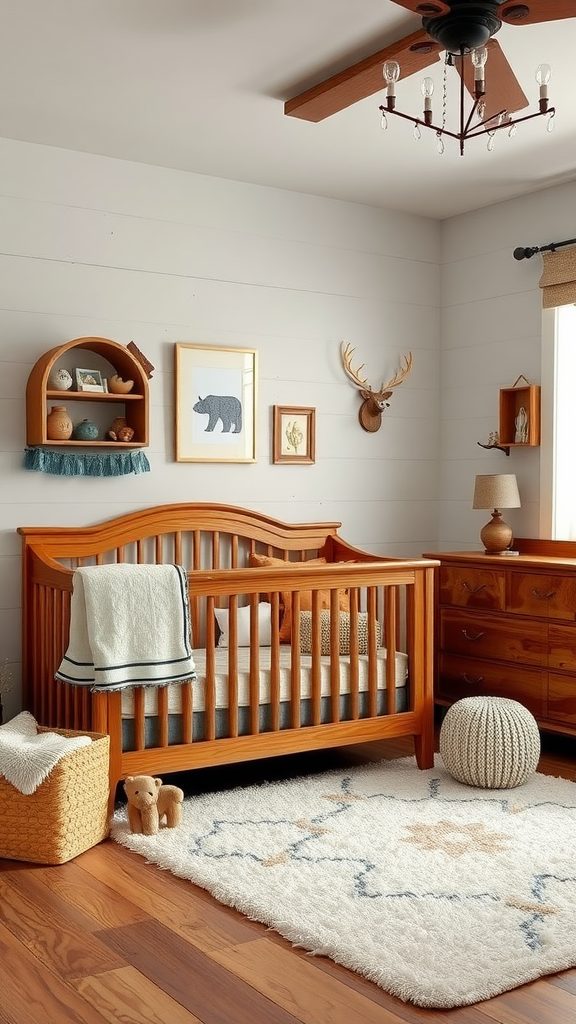
Traditional depictions of animals through illustrated plates, carved wooden figures, or classic stuffed toys bring naturalist charm to vintage nurseries. Unlike cartoon characters that quickly feel dated, these timeless representations foster appreciation for wildlife while maintaining sophisticated design integrity.
Look for Audubon-style bird illustrations, traditional carved wooden zoo animals, or classic teddy bears with articulated limbs and button eyes. Display collections in curated groupings—perhaps woodland creatures in one area, farm animals in another—to create deliberate design moments throughout the room. These elements connect your child to natural history traditions while providing gentle companions for imaginative play.
12. Traditional Textile Accents
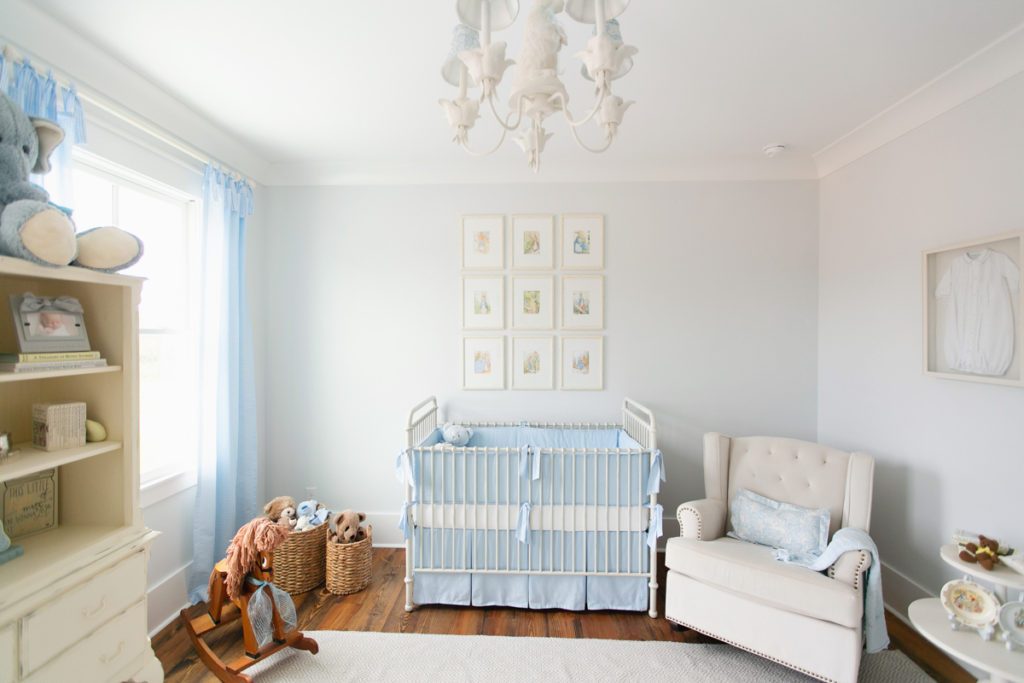
Hand-crafted textiles like crocheted blankets, embroidered pillow shams, and hand-stitched quilts bring irreplaceable warmth and texture to vintage nurseries. These heirloom-quality pieces often carry family history, creating emotional connections to previous generations through tangible objects your baby will use daily.
Layer textiles of varying weights and textures to create visual depth and practical options for different seasons. A display rack for special quilts keeps them visible when not in use, while woven baskets can store lighter blankets within easy reach. Traditional patterns like log cabin quilts, cable-knit blankets, or cross-stitched motifs contribute to the authentic vintage atmosphere while providing sensory stimulation important for development.
13. Historic Architecture Highlights

Emphasize original architectural features in older homes—crown molding, wainscoting, transom windows, or built-in cabinets—to establish authentic vintage character. These elements provide natural starting points for period-appropriate design that honors your home’s history while creating a distinctive nursery environment.
In newer construction, add architectural interest through applied moldings, beadboard paneling, or vintage hardware that references historical styles. Window treatments play a crucial role; consider shutters, café curtains, or simple roller shades reminiscent of early 20th-century homes. These subtle architectural details create a solid foundation for vintage furnishings and accents.
14. Apothecary Storage Solutions
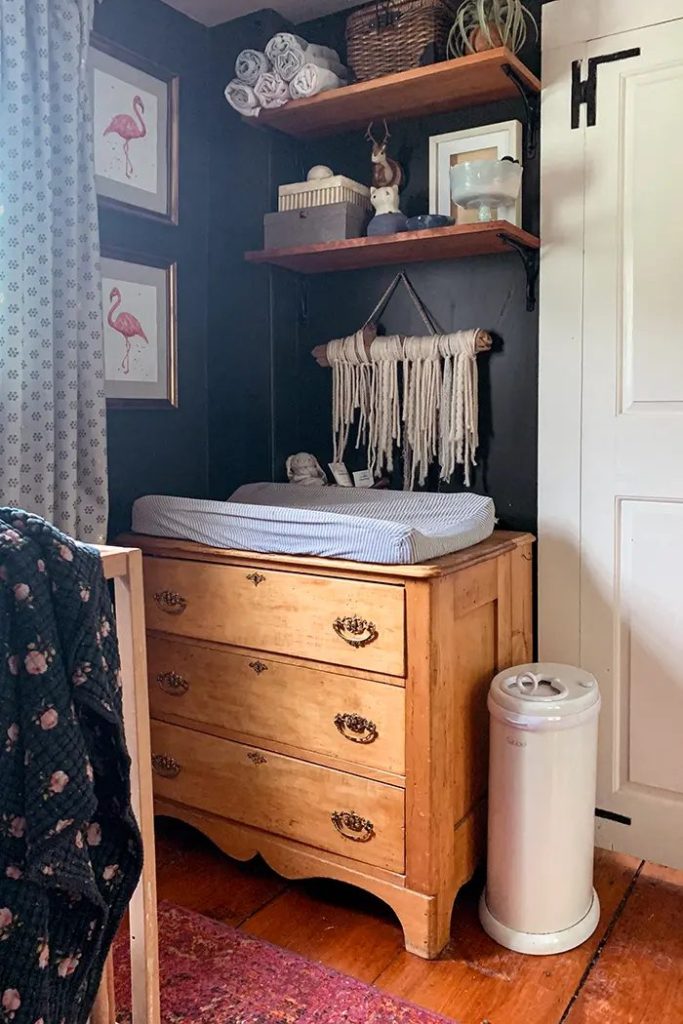
Pharmaceutical cabinets, card catalogs, and multi-drawer apothecary chests offer organizing solutions with distinct vintage personality. These pieces typically feature numerous small compartments perfect for categorizing baby supplies, from tiny socks to grooming implements, while their distinctive appearance recalls old-world shops and libraries.
The solid construction of authentic apothecary furniture ensures durability through years of use, while brass label holders can be customized to identify contents—practical for caregivers and eventually educational for your growing child. Position these pieces within easy reach of changing areas to maximize functionality while allowing their unique character to enhance the room’s vintage aesthetic.
15. Heirloom Lighting Fixtures

Period-appropriate lighting creates ambiance while establishing historical context for vintage nurseries. Consider converted oil lamps, rewired industrial fixtures, or restored chandeliers that provide layered illumination for different activities—bright light for changing, moderate illumination for playtime, and soft glows for bedtime routines.
Ensure all vintage lighting is professionally rewired to modern safety standards and installed with dimmer switches that allow customized lighting levels. Supplement ceiling fixtures with table lamps featuring ceramic bases and fabric shades that diffuse light gently. For night illumination, antique night-light covers or repurposed lanterns provide reassuring gentle glow without disrupting sleep cycles.
Conclusion
Creating a vintage-inspired nursery for your baby boy offers more than aesthetic appeal—it establishes a foundation of heritage, craftsmanship, and timeless design that will grow alongside your child.
By thoughtfully combining authentic period pieces with modern safety standards, you create a space that honors traditional values while meeting contemporary needs. These fifteen approaches demonstrate how vintage elements can transform an ordinary room into an extraordinary environment filled with character and meaning.
As you select items for your vintage nursery, prioritize pieces with stories, craftsmanship, and durability that will withstand years of use.
The patina of age on restored furniture, the hand-stitching on heirloom textiles, and the mellow glow of antique lighting all contribute to an atmosphere of permanence and care that modern, mass-produced nurseries often lack.
In creating this thoughtful space for your son’s earliest years, you’re not just designing a room—you’re crafting the backdrop for cherished memories and establishing traditions that may extend to future generations.

